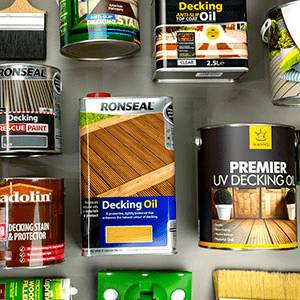Wall and Ceiling Finishes FAQ
What is the best paint for walls?
This depends on if it is an interior or exterior wall. For masonry and brick walls we recommend Sandtex exterior masonry paints. For interior walls we have a range of Interior wall and ceiling paints.
How can I seal gaps between interior walls and window frames?
For gaps between interior walls, window and door frames we recommend Osmo Interior Gap Sealer or Bona Gap Master. These highly versatile gap fillers can be used on stone, concrete and brick walls to seal gaps between walls and fixtures.
What is the best way to remove green growth on a brick wall?
To remove green growth from concrete, stone and brick walls we recommend Barrettine Mould and Mildew Cleaner. For heavily soiled walls a second application may be required. We recommend that before treating, clean the wall with a scraper, stiff broom or brush to remove as much surface matter as possible prior to treating.
Is there an eco friendly paint I can use for bedroom walls and ceiling?
Earthborn Clay Paint is made from purely natural ingredients and is perfect for use on interior walls and ceilings. It is wipable and available in a wide range of attractive colours. It dries to a luxurious ultra-matt finish, can benefit allergy and asthma sufferers, is odourless and virtually V.O.C free.
I have a small box room that needs painting. I would like to use a colour but I'm afraid that a coloured paint will make the room appear even smaller. Do you have any suggestions?
I have moved into a new house and am looking to redecorate each room. Which type of paint is best?
We're going to make some assumptions about your question as unfortunately, it wasn't very specific. In terms of walls and ceilings, the norm is to paint these with a durable emulsion paint. For ceilings, most people usually go for a white or brilliant white paint but this isn't always the case. We're assuming that in terms of the walls, you'll be looking for an emulsion paint that is available in a range of colours.
In terms of sheen level, there is a choice of either going for a paint that gives a soft sheen, or one that provides a matt finish. Matt emulsion paints are more forgiving as they are better at hiding any slight imperfections if the walls are not perfectly straight. Many would also say that a matt finish gives a more modern look.
Both Crown paints and Dulux offer a range of paints for walls and ceilings as well as others for interior wood and metal if you have skirting boards, architraves and other fixtures to paint. One option that could work well for walls is Dulux Matt Paint for walls and ceilings. This is a durable emulsion paint that is available in a wide range of Dulux colours.
For alternative options, see our full range of Crown paints and Dulux paints.
What type of paint should I use for a busy hallway?
Emulsion paints are the norm for walls and ceilings in most rooms but in the past, emulsions used to be susceptible to scuffs, marks, stains, and dirt. When trying to wipe these clean, it often resulted in an amount of paint also being wiped off. This was far from ideal in busy hallways, living rooms, and children's bedrooms, where dirty marks and scuffs are common.
Thankfully, paint technology has evolved over the years and newer emulsion paints are much more durable than they used to be. A great example of this is Dulux Easycare Washable and Tough Matt , this emulsion paint has been developed to be 20 times tougher than standard matt emulsion, contains unique stain repellent technology to prevent staining, and can be wiped down without causing damage or colour fade. This makes it especially suitable for hallways, living rooms, and children's bedrooms. Dulux Easycare Washable and Tough is also available in a wide range of Dulux colours.
I am in the process of redecorating a whole house, can you recommend some paints for the walls and ceilings? I'm more drawn to Dulux paints than others.
We stock a whole range of Dulux wall and ceiling paints. Modern paint technology has come a long way over the years and modern emulsion paints are now far more durable and washable than paints of yesteryear.
For kitchens and bathrooms, where moisture, stains, and grease can be an issue, consider Dulux Easycare Bathroom Soft Sheen and Dulux Easycare Kitchen Matt. For small rooms, consider Dulux Light and Space Matt Paint which is designed to make small spaces lighter, thus making them feel bigger, by using special light reflecting pigments in the paint.
The Dulux paint range offers a full range of white and Dulux colour paint finishes making them ideal for a project like this.
How do I remove paint from a brick wall?
Removing paint from a brick wall with a conventional paint stripper such as Paint Panther Paint and Varnish Remover can be fiddly due to the nature of the textured surface of bricks and stone, and not easily being able to use a paint scraper. An alternative product that works well on brick, concrete and plaster walls, interior and exterior, is PeelAway. This is a poultice (paste like product) that is applied to the surface of the wall to be stripped, then covered with a plastic blanket (supplied) to prevent the paste from drying out too quickly. The poultice works by dissolving and absorbing the paint and pulling it away from the wall when the poultice is removed. It's perfect for removing paint from textured surfaces or surfaces with detailing. Our recommendation is to try the PeelAway 1 and 7 Sample Twin Pack to find out which remover is effective on the paint that is to be removed. It may be the case that PeelAway 7 is needed for the top coats and PeelAway 1 for deeper, older coats of paint.
The PeelAway paint removal system comes in 2 variations. PeelAway 1 Paint Remover is a caustic based paint stripper that is better on older paints from the 1970's and prior, that may contain Lead or other metal substances, PeelAway 7 Paint Remover is better on modern paint formulation from the mid 1970's onwards.
When removing paint from exterior walls we strongly recommend doing a test area before starting any project, to test product suitability and effectiveness.
Wall and Ceiling Paints
Disclaimer: Whilst every attempt has been made to provide product information that is as accurate as possible, it's important to clarify that trees and the wood that they produce can be affected by many factors. For example, the same species of tree grown in the same wood, even in close proximity, will be affected by age along with the amount of sunlight and water they receive. Other naturally occurring biological and environmental factors will also influence the density and grain of the wood as well as the moisture and oil content of the timber. No two trees are the same, meaning each piece of wood has the potential to look and react differently to the same wood finish. For example, product adhesion, colour variations, absorption rates and sheen levels. It is for this reason that we always strongly recommend carrying out test areas before starting any project


